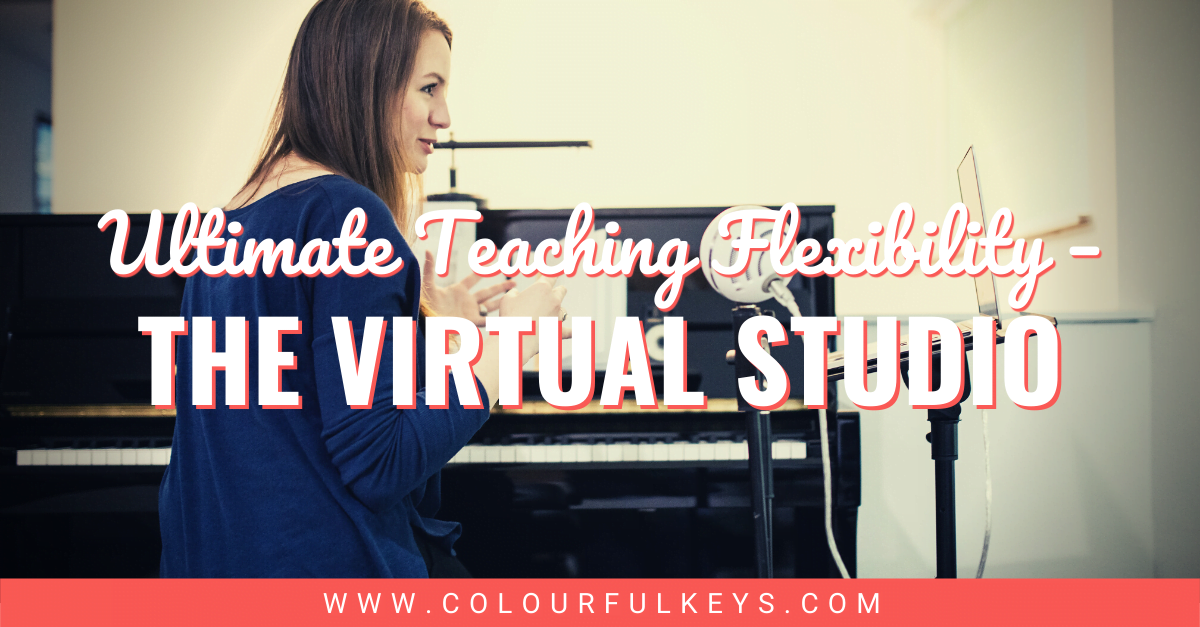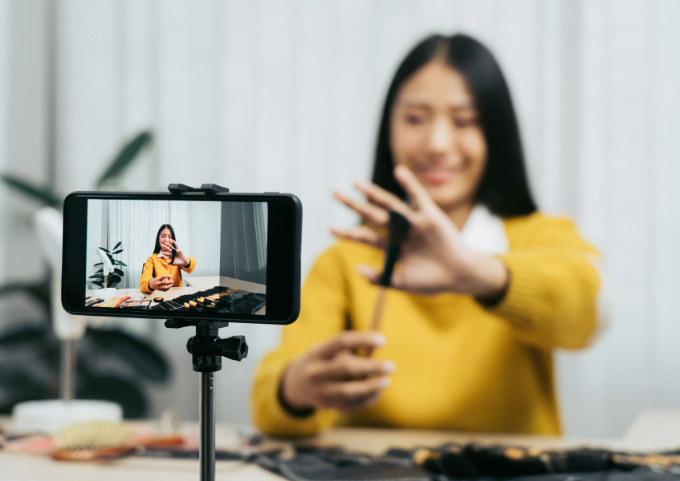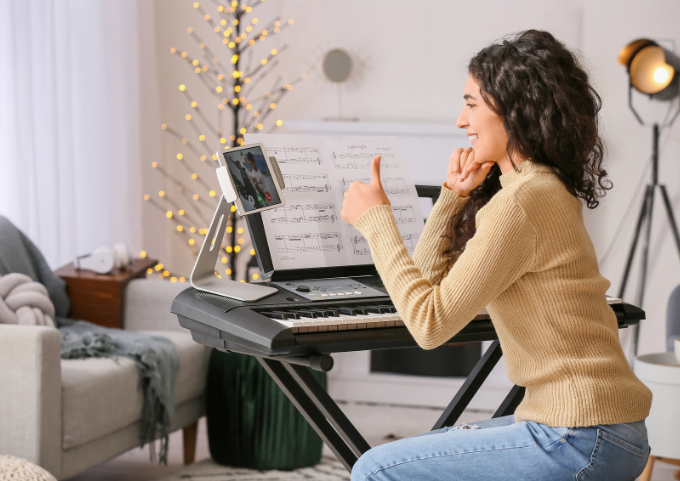
This article about setting up your own ‘virtual studio’ was written by Janna Carlson. Janna built her own studio website in 2013. To make it less miserable, she took her laptop to a brewery and sipped on half-pints of dark beer while she struggled to learn her way around Squarespace.
Nine years later, she and her husband, Jeremy, now build websites for music teachers through Studio Rocket Web Design. They live for the moments when clients come back, bursting with excitement about what their new website has helped them accomplish in their studio. Janna is located in Washington State, USA where she also teaches piano online, tries to grow things in her garden and spoils the family tuxedo cats, Fred & Ginger.
Have you ever wished you could step away from your studio for a week (or several!) and have it run without you? Maternity leave, an upcoming move, a sick family member who needs your care, a restorative break or…you fill in the blank.
I’ve discovered a way to keep your studio running…without needing to be there!

Our family is planning a move to Portugal soon, so we took a two-month scouting trip to decide where we wanted to settle.
The big challenge? Our trip was scheduled right over the start of my studio year. And because of how frequently we’d be travelling between towns, holding lessons online wouldn’t be possible.
So I came up with a way to keep my students enrolled in my studio, practising and moving forward for the first two months of our term, without a single live piano lesson.
This is a solution which offers huge flexibility to any teacher with a website, whatever your reason for needing time away.
What is a ‘virtual studio’, anyway?
A virtual studio is a password-protected page on your website which houses lesson material for your students to access on their own.
This can include a variety of materials such as:
- Printable sheet music
- Instructional videos (rote or otherwise)
- Audio tracks
- Downloadable PDFs (with instructions, games etc.)
- Printable theory pages
- Links to outside resources
- Practice charts (I like sharing these in Google Docs so students can edit them)
- A practice ‘Hall of Fame’
- Event information or studio calendars
A virtual studio can be as simple as printable theory worksheets you don’t have time to cover in a lesson, or it could have enough content to fully support your studio with lesson material for a week – or several!
Benefits of Having a Virtual Studio
A virtual studio offers huge flexibility when sharing learning material with students. Here are just a few ideas of how you could benefit from having your own virtual studio.
Stop Offering Make-Up Lessons
Set up your virtual studio with a lesson’s worth of material for each skill level you teach. When a student cancels a lesson, instead of trying to squeeze in a make-up lesson, simply give them the password to your virtual studio and encourage them to enjoy their fun week of practice. You could refresh your virtual studio content each semester or as often as needed.
Take a Week Off to Care for a Family Member
Look through your digital music library and add a piece for each level you teach. Include brief instructions on learning the new piece – either written or in a quick video – if desired.

In less than an hour, you can have a simple virtual studio to give your students a fresh challenge while giving yourself time away for an unexpected need.
A Fun Self-Paced Summer Program
Record a set of videos on any topic you want: pop music, improvisation, chord patterns in hymns or anything else. Add a collaborative group chart to help everyone track their progress (digital badge boards are fantastic for this) and host a final group celebration (either in-person or online) at the end of the program.
Maternity Leave Without Compromising Student Progress
This requires some planning and prep, but thankfully with maternity leave you do have advanced notice and plenty of time to prepare. 😉
With all of your content created ahead of time, updating your lesson material while on leave will be easy. You could even get an assistant to swap it out every week or 2.
What a Virtual Studio Does NOT Do
A virtual studio offers you scheduling freedom while increasing the perceived value of your studio (and it flexes beautifully with families’ busy schedules).
However, virtual studios are NOT designed to replace lessons in the long term.
Ultimately, a virtual studio does not replace YOU.
Towards the end of my 2-month sabbatical, my students’ motivation took a dive. It was clear that 2 months was the most I could ask of them with independent progress, and we were all excited to get back to our live weekly lessons.
Students thrive when they have our attention, expertise and direct engagement with them.
My ‘Virtual Studio’ Experiment
This idea had been floating around in my head for awhile, so finally I decided to test it out.
I wanted to see if my students could make progress with a more self-guided learning structure, but I didn’t want to jump straight into launching a full-blown virtual studio without knowing if this idea was going to work.
So, I started small. I replaced 2 weeks of normal piano lessons with material shared through my studio website.
Here’s the process I went through.
Experiment Step 1: Creating Some Test Content
I decided to create some test content first to see if this idea would work out for me in the long term.
I began by recording 2 sets of instructional videos split into multiple levels. I chose 2 familiar songs for my students to learn: The Wellerman (a popular sea shanty) and Yellow Submarine by The Beatles.
I arranged each one simply, broke the arrangements into multiple skill levels and recorded a rote instructional video for each level.
I also made an audio recording of each piece in its full arrangement, so students could experience the fun and big sound of playing with a “duet part” once they felt confident with their own part.
Experiment Step 2: Creating a House for the Test Content
Next, I built a password-protected page on my studio website. I organised the two sets of videos on the page, along with audio duet tracks for each.
I introduced families to our new online “studio clubhouse” (don’t forget to give it a good name) and shared clear instructions on how to access it. I made it fun! This was music which felt exciting and gratifying to play; it was a reward after a semester of diligent practice.
Experiment Step 3: Follow-up and Feedback
At the end of the 2 weeks, we met together in an online group lesson and played the pieces we’d learned.
It was a huge hit! 🎉

The best feedback was from the mum of a student who struggles to retain what we do in one-on-one lessons. This student LOVED being able to watch the rote videos as many times as needed, going at his own pace. He’d learnt to play his pieces with a level of confidence I’d rarely seen in him.
Setting Up a Virtual Studio
Before you get started on your own, you’ll need a studio website. You’ll also need to know how to add videos, links and other types of content such as audio tracks or PDFs.
It’s OK if it takes you awhile to get the hang of editing your site at first; it will get easier as you work with your virtual studio.
Step 1: Plan and Create Content
You’ll want to start by mapping out your musical goals and lesson plans. I recommend choosing a topic or approach which can be tailored for multiple levels.
With my own virtual studio, I found that students take about 2 weeks to get through a “normal” week’s worth of material so plan accordingly.
Pro tip: Start small. You don’t want to overwhelm yourself!
Then get to work creating the content you’ll use for your virtual studio. You could record videos and audio tracks, gather music, find worksheets, create practice incentives etc. – whatever you think would best support your musical goals for that period.
Step 2: Create the Area
Add a new password-protected page to your website. I like to use a single, studio-wide password to keep things simple for everyone. (After all, you can always change it for a new enrollment period.)
Step 3: Organise
Next, arrange your content in a way which makes it easy for students to find what they need.
Will you organise it by level? By assignment? By practice order?
Avoid the urge to add a lot of content all at once. A student needs to be able to find what they need quickly, and you can always change the content down the road.
Step 4: Save and Test
Once you’ve added your content, save your work and test everything!

Click every link and play the beginning of every video. Yes, it does take time. But this will ensure that you don’t receive frustrated emails from parents who can’t get a video to play, etc. The experience needs to be easy and fun for your students from the very beginning.
Step 5: Share
Finally, share your virtual studio details in an email with a clear title (“Virtual Studio Instructions” or similar) so it’s easy for parents to find down the road.
Pro tip: Schedule email reminders and prompts to go out every week or two while you’re away.
Introducing Your Virtual Studio to Parents
When introducing any new studio changes to parents, remember the golden rules:
- Keep it positive
- List all the benefits parents will receive with this new way of taking piano lessons.
- Don’t apologise
- Make it fun, exciting, interesting and engaging
- Be in charge: You’ve made the decision
FREE ‘Virtual Studio’ Handbook
Want to build your own virtual studio – but need more guidance?
I’ve created ‘The Virtual Studio Handbook’ to help, and you can download it for FREE!
This guide will help you sketch out your own virtual studio and guide you through the steps to build it. All you’ll need to get started is a website and a working knowledge of how to edit it.
How could a ‘virtual studio’ transform your business?
Let us know in the comments what dream a virtual studio could bring into reality for you.
Nicola has an entire hub filled with resources to help you plan your music lessons. Check it out!
